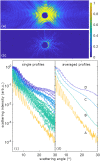Imaging plasma formation in isolated nanoparticles with ultrafast resonant scattering
- PMID: 32596413
- PMCID: PMC7304997
- DOI: 10.1063/4.0000006
Imaging plasma formation in isolated nanoparticles with ultrafast resonant scattering
Abstract
We have recorded the diffraction patterns from individual xenon clusters irradiated with intense extreme ultraviolet pulses to investigate the influence of light-induced electronic changes on the scattering response. The clusters were irradiated with short wavelength pulses in the wavelength regime of different 4d inner-shell resonances of neutral and ionic xenon, resulting in distinctly different optical properties from areas in the clusters with lower or higher charge states. The data show the emergence of a transient structure with a spatial extension of tens of nanometers within the otherwise homogeneous sample. Simulations indicate that ionization and nanoplasma formation result in a light-induced outer shell in the cluster with a strongly altered refractive index. The presented resonant scattering approach enables imaging of ultrafast electron dynamics on their natural timescale.
© 2020 Author(s).
Figures




References
-
- Feldhaus J., Krikunova M., Meyer M., Möller T., Moshammer R., Rudenko A., Tschentscher T., and Ullrich J., “ AMO science at the FLASH and European XFEL free-electron laser facilities,” J. Phys. B 46, 164002 (2013).10.1088/0953-4075/46/16/164002 - DOI
-
- Bostedt C., Boutet S., Fritz D. M., Huang Z., Lee H. J., Lemke H. T., Robert A., Schlotter W. F., Turner J. J., and Williams G. J., Rev. Mod. Phys. 88, 015007 (2016).10.1103/RevModPhys.88.015007 - DOI
-
- Bencivenga F., Capotondi F., Principi E., Kiskinova M., and Masciovecchio C., “ Coherent and transient states studied with extreme ultraviolet and x-ray free electron lasers: Present and future prospects,” Adv. Phys. 63, 327–404 (2014).10.1080/00018732.2014.1029302 - DOI
-
- Yabashi M., Tanaka H., Tanaka T., Tomizawa H., Togashi T., Nagasono M., Ishikawa T., Harries J. R., Hikosaka Y., Hishikawa A., Nagaya K., Saito N., Shigemasa E., Yamanouchi K., and Ueda K., “ Compact XFEL and AMO sciences: SACLA and SCSS,” J. Phys. B 46, 164001 (2013).10.1088/0953-4075/46/16/164001 - DOI
-
- Chapman H. N., Barty A., Bogan M. J., Boutet S., Frank M., Hau-Riege S., Marchesini S., Woods B., Bajt S., Benner W. H., London R. A., Plonjes E., Kuhlmann M., Treusch R., Dusterer S., Tschentscher T., Schneider J. R., Spiller E., Möller T., Bostedt C., Hoener M., Shapiro D. A., Hodgson K. O., van der Spoel D., Burmeister F., Bergh M., Caleman C., Huldt G., Seibert M., Maia F. R. N. C., Lee R. W., Szoke A., Timneanu N., and Hajdu J., “ Femtosecond diffractive imaging with a soft-x-ray free-electron laser,” Nat. Phys. 2, 839–843 (2006).10.1038/nphys461 - DOI
LinkOut - more resources
Full Text Sources

